What Animals Are In The Tundra Biome
For almost of the yr, the tundra biome is a cold, frozen landscape. This biome has a short growing season, followed by harsh conditions that the plants and animals in the region demand special adaptations to survive. Tundra form in ii singled-out cold and dry regions. Arctic tundra are found on high-breadth landmasses, above the Chill Circle—in Alaska, Canada, Russian federation, Greenland, Iceland, and Scandinavia, for example—or on far southern regions, like Antarctica. Alpine tundra are located at very high elevations atop mountains, where overnight temperatures fall below freezing. Tundra regions typically get less than 25 centimeters (ten inches) of precipitation annually, which means these areas are also considered deserts. They accept long, cold winters with loftier winds and boilerplate temperatures beneath freezing for six to 10 months of the twelvemonth. On boilerplate, simply half-dozen to x weeks of the year have sufficiently warm temperatures and long days for institute growth. The soil in the Arctic is largely permafrost or soil that remains frozen yr-round, leaving only a sparse surface layer of thawed soil in summer for plant roots to grow in. Tundra soil is too scarce in many of the nutrients that plants need to grow. These atmospheric condition lead to one of the tundra biome's about singled-out features: They are largely treeless. (The word "tundra" derives from the Finnish word tunturia, pregnant barren or treeless hill.) Instead, the tundra has patchy, low-to-ground vegetation consisting of pocket-sized shrubs, grasses, mosses, sedges, and lichens, all of which are amend adapted to withstand tundra conditions. Animals in the tundra are also adapted to extreme conditions, and they have advantage of the temporary explosion of establish and insect life in the short growing season. Tundra wildlife includes pocket-sized mammals—such as Norway lemmings (Lemmus lemmus), chill hares (Lepis arcticus), and arctic basis squirrels (Spermophilus parryii)—and big mammals, such as caribou (Rangifer tarandus). These animals build upward stores of fat to sustain and insulate them through the winter. They likewise have thick coats of fur for further insulation. Some save energy by hibernating during the long winter months. Others drift to warmer climes during winter. Many birds also migrate into the tundra during the growing flavor to feed, mate, and nest. Atop the food chain are tundra carnivores, such as chill foxes (Vulpes lagopus), chill wolves (Canis lupus), snowy owls (Bubo scandiaca), and polar bears (Ursus maritimus), which move into the tundra during the summertime when prey is plentiful and their usual hunting grounds on sea water ice diminish. Many animals, both predator and prey, develop white fur or feathers in the winter months for camouflage in ice and snow. Tundra insects take also developed adaptations for the cold; mosquitoes (Aedes nigripes), for example, have a chemical chemical compound that acts as antifreeze, lowering the freezing temperature in their actual fluids. Though the tundra is remote, it is increasingly threatened as people interlope on it to build or drill for oil, for example. Perhaps the greatest danger, however, comes from climate change. Warming temperatures could disrupt the cold tundra biome and the life in it, equally well as thaw its underlying permafrost, releasing greenhouse gases that would further accelerate global warming.

A defining feature of the tundra is the distinct lack of trees. There are a diversity of reasons trees don't grow in this region. First, the permafrost prevents them from taking root, and then those that do manage it accept shallow root systems that are not an ideal anchor to withstand the loftier winds. Finally, low precipitation means at that place is not plenty water to support trees.
Paul Nicklen
alpine tundra
Noun
flat, treeless vegetation region separated from a forest by the tree line.
animal migration
Noun
process where a community of animals leaves a habitat for part of the twelvemonth or part of their lives, and moves to habitats that are more hospitable.
arctic tundra
Noun
flat, treeless vegetation region well-nigh the Arctic Circle.
Substantive
area of the planet which tin be classified according to the institute and creature life in it.
Noun
tactic that organisms use to disguise their appearance, usually to blend in with their environment.
Noun
organism that eats meat.
climate
Noun
all atmospheric condition conditions for a given location over a catamenia of time.
greenhouse gas
Noun
gas in the temper, such as carbon dioxide, methyl hydride, water vapor, and ozone, that absorbs solar heat reflected by the surface of the Earth, warming the temper.
lichen
Noun
organism composed of a fungus or fungi and an alga or cyanobacterium.
Substantive
movement of a group of people or animals from one place to another.
Noun
permanently frozen layer of the World'due south surface.
predator
Noun
animal that hunts other animals for food.
prey
Substantive
beast that is hunted and eaten past other animals.
tundra
Noun
cold, treeless region in Arctic and Antarctic climates.
tundra climate
Noun
region that experiences short summers and long winters.
Source: https://www.nationalgeographic.org/encyclopedia/tundra-biome/
Posted by: wilsonsperoar86.blogspot.com

0 Response to "What Animals Are In The Tundra Biome"
Post a Comment